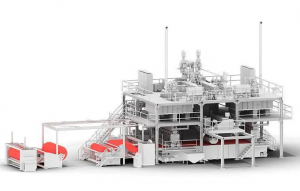In recent years, the growth rate of world demand for nonwoven fabrics has always been higher than the growth of the global economy. Global nonwoven production is mainly concentrated in the United States, accounting for 41% of the world total, Western Europe accounts for 30%, Japan for 8%, China for 3.5% and other regions for 17.5%. Among the end-use applications of nonwovens, hygiene absorbent (especially diapers) products are growing fastest, and medical textiles, automotive textiles, footwear and artificial leather markets are also showing new and rapid development.
Non-woven bag-making machine is fed by a feeder to send powder (colloid or liquid) to the hopper above the packaging machine, the introduction speed is controlled by photoelectric positioning device, the roll of sealing paper (or other packaging materials) is driven by the guide roller and introduced to the collar former, which is bent and then lapped by the longitudinal sealer to become a cylinder, the material is automatically measured and filled into the bag made, and the horizontal sealer intermittently tows the bag cylinder while the heat seal is cut. The material is automatically measured and filled into the bag.
Several main functions of the bag-making process
Bag-making process generally has several main functions
The bag-making process generally has several main functions, including material feeding, sealing, cutting and bagging.
In the feeding section, the flexible packaging film fed by the rollers is unrolled by a feeding roller. The feed rollers are used to move the film within the machine to perform the desired operation. Feeding is generally an intermittent operation, such as sealing, cutting, and other operations that take place during feed aborts. Dancer rolls are used to maintain a constant tension on the film rolls. The feeder and dancing rollers are necessary to maintain tension and critical feeding accuracy.
In the sealing section, temperature controlled sealing elements are moved to touch the film for a specific length of time in order to properly seal the material. The sealing temperature and length of time varies by material type and needs to be stable at different machine speeds. The equipment of the sealing elements and the machine layout associated with them depend on the type of seal specified in the bag plan. In most machine operations, the sealing process is accompanied by the cutting process, and both operations are performed at the end of feeding.
During the cutting and bagging operation, operations such as sealing are generally performed during the non-feed cycle of the machine. Similar to the sealing process, the cutting and bagging operations also determine a good machine method. In addition to these basic functions, the performance of additional operations such as zippers, perforated bags, tote bags, damage-resistant sealing, spouting, crown handling, etc. may depend on the bag design. Accessories attached to the basic machine perform such additional operations.
Post time: Mar-24-2022


